
“It’s not the size of the dog in the fight. It’s the size of the fight in the dog.” ~Mark Twain
After carrying a CJRB Maileah everyday for nearly six months, I think I can lend my honest, broken-in opinion on what sort of knife this is, what sort of tasks it excels at, and who would benefit from carrying one.
Something I did know when I purchased this novel-looking knife: it was designed by a woman who goes by the moniker of Sharp and Pointy Swaggs.
Something I did not know: apparently, this knife was expressly designed for women, too. It’s a small knife that’s more comfortable in smaller hands, but apparently it’s also intentionally very slim to fit in women’s jeans pockets. Who knew? I didn’t.
Does that make a difference to me? Not one bit.
Does it affect the functionality or utility of this knife? Also not one bit.
This knife has a sort of blade that some would call a pocket cleaver and others would call a “reverse tanto.” It may be tiny, but it is not dainty.
So anyway, let’s talk about the specifications of this knife.
CJRB Maileah Specifications
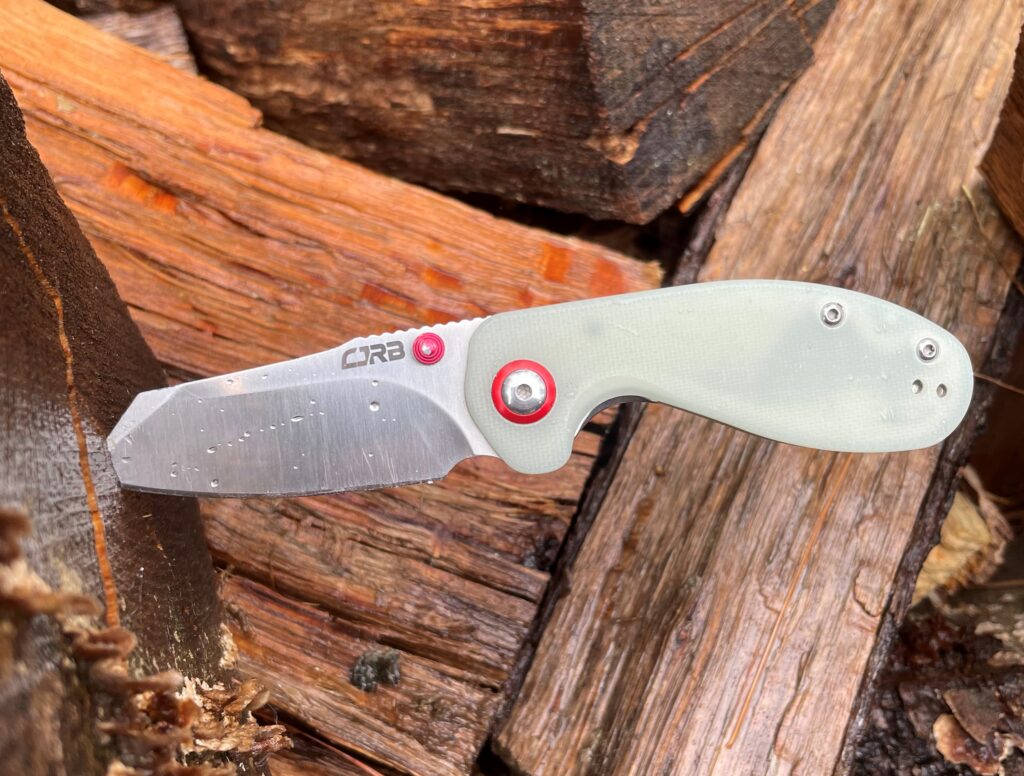
The CJRB Maileah is 3.14” closed and 5.50” open, with a 2.375” blade. The blade steel is a steel that’s known as AR-RPM9. Before I got this knife I’d never heard of this steel before. (More on that in a moment.)
The blade is available either with a black physical vapor deposition (PVD) coating or a bead-blasted, semi-polished finish. According to CJRB, the grind is flat. It’s hard to tell in pictures, but if you handle one of these knives, it really actually looks and seems like a slightly convex grind. This reminds me of the CRKT Pilar (another knife I absolutely love) and it really works for this style of blade. The thicker the stock, the better.

The Maileah comes with G10 scales. There are some exclusive models floating around out there, but you can pretty much find black, red or light, nearly white, greenish scales anywhere. No matter which color you get, the Maileah comes with red accents – the ambidextrous thumb studs and pivot hardware have a red finish. (I got the version with the whitish scales because I got the best price on it.)
The Maileah comes with a pocket clip that allows for tip up deep carry and can be positioned on either side of the knife. Something nice about the pocket clip is that there is a cut-out that enables you to easily access the screws so you can switch things up. This doesn’t matter to me, though, since I hardly ever use the clip. (I only rarely use the clip. For instance, when I’m on the water and sitting on a hard canoe seat or thwart. Then it’s uncomfortable to have a knife under me in my pocket. The clip comes in handy then.)
There is a lanyard hole between the scales, which is nice for some users, though I typically don’t outfit my knives with lanyards. That is, perhaps, a topic for another blog (making a mental note).
This knife features a liner lock mechanism and the pivot assembly contains a ceramic caged ball bearing. It has thumb studs on both sides of the blade and a spur along the top of the spine, where the tang would be. It’s called a front flipper, and makes it easy (with a little practice) to flip open the knife with your thumb (more information below).
Overall, the whole thing weighs only 2.29 ounces.
About AR-ARP9 Steel

I personally think the AR-RPM9 that CJRB uses to create the Maileah, and some of their other knives, deserves a special note.
This is not a commonly encountered steel but you might be interested to learn (as I was) that this is actually a powder metallurgy steel.
Powder metallurgy steels include the infamous CPM lines of steel, like 20CV and 35VN that are considered super steels and offer excellent balances of toughness, hardness (edge retention) and corrosion resistance.
Am I attempting to equate AR-RPM9 with any of those super steels? Certainly not. But this is also not your run-of-the-mill AUS 8 or 420HC.
AR-RPM9 contains a unique mix of 9 main elements in its chemical composition, which is evidently where the 9 comes from. The main ones you need to know about are carbon (.9%), chromium (18%), vanadium and molybdenum (.1% and 1%, respectively).
This steel has basically as much carbon as 1095, which gives it the ability not only to take a razor sharp edge but also to hold it for a decent length of time.
That’s a very high concentration of chromium, too, which gives this steel excellent corrosion resistance. I haven’t taken it fishing in saltwater yet, but I have no doubt it will buck the elements with impressive poise. It’s pretty humid where I live year round, and there is not a speck of rust anywhere on this knife, despite having been outside for many hours, and several days, in the rain.
For those of you unfamiliar with vanadium and molybdenum in steel, these elements can make a steel alloy very tough, increasing its resistance to impulse. In other words, high vanadium and molybdenum steels are very strong and less likely to chip, crack or snap.
Vanadium also forms carbides, which are extremely hard compounds which improve edge retention.
So, the takeaway here is that AR-RPM9, though it may not be the best steel in the industry, is pretty tough and very corrosion resistant. While it doesn’t hold an edge forever, it takes a very sharp edge and holds it for a while.
So, what is it that compelled me to write about this knife?
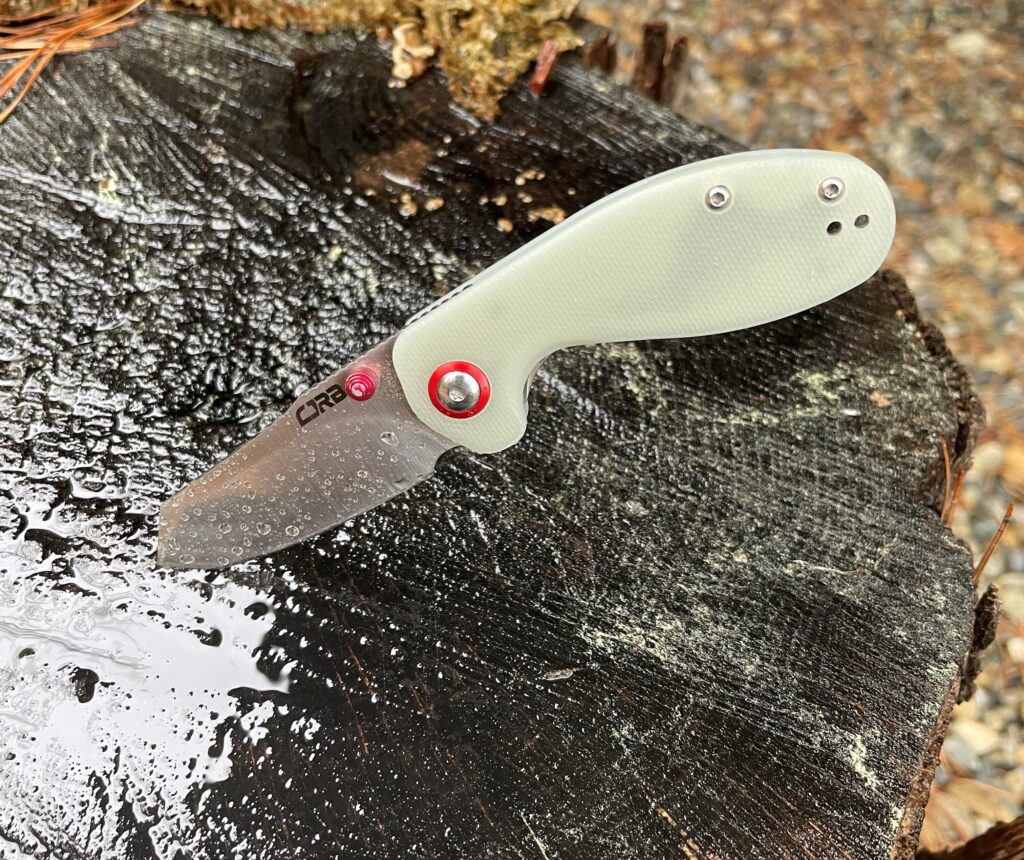
What the CJRB Maileah Does Well
IIt took me a long time looking at this knife online before I actually pulled the trigger. I knew immediately, despite the size, that a knife with a short straight edge and a tough tip was perfect for me. (I tend to beat up my EDC knives. I’ve broken the locks on several OKC RAT II’s in the past couple years). I needed something short, stout and tough.
Folded, it doesn’t really look that intimidating. It’s rounded and almost jelly bean shaped. But, it’s very slim and very light. It’s almost impossible to feel when it’s in my pocket, unless I sit directly on it.
There are no harsh angles that stick into you. Some folders have high, sharp thumb studs that stick into you when you sit on them. This knife is not like that.
Like I said, I don’t really use the pocket clip, but when I do, it’s almost impossible to notice the knife is even there.
This knife is very comfortable in the hand before you even flick it open. The edges of the scales are rounded off. They’re not as comfortable as some other knives, but G10 can be really sharp and harsh angles angles create hot spots, so I appreciate the design.
I really love deployment on this knife, possibly more than any other folder I’ve ever handled or carried. The ambidextrous thumb studs and front flipper give you a wealth of options for deployment.
It’s easy to flick this knife open using your dominant thumb and the corresponding thumb stud. I’m right handed, and when I snap open the knife this way, it ends up in a “ready” position in my hand. Not all knives do that.
The front flipper is even better. When you open this knife using your thumb and the flipper, the knife naturally situates itself in a reverse grip, which is perfect for draw cuts.
You can also modify your reverse grip on the knife and wedge your thumb into the choil to make draw cuts, as shown below. This is not a feature I capitalize on much, but the fact that the knife is flexible and versatile enough to allow for it is nice, if you ask me.

This reverse orientation is actually more comfortable than the standard hammer or saber grips. The choil cut out of the scales fits right in the groove between your thumb and index finger very comfortably. You can actually hold the knife like this and use your hands (cautiously) without too much concern of the edge, as it will be turned away from your fingers.
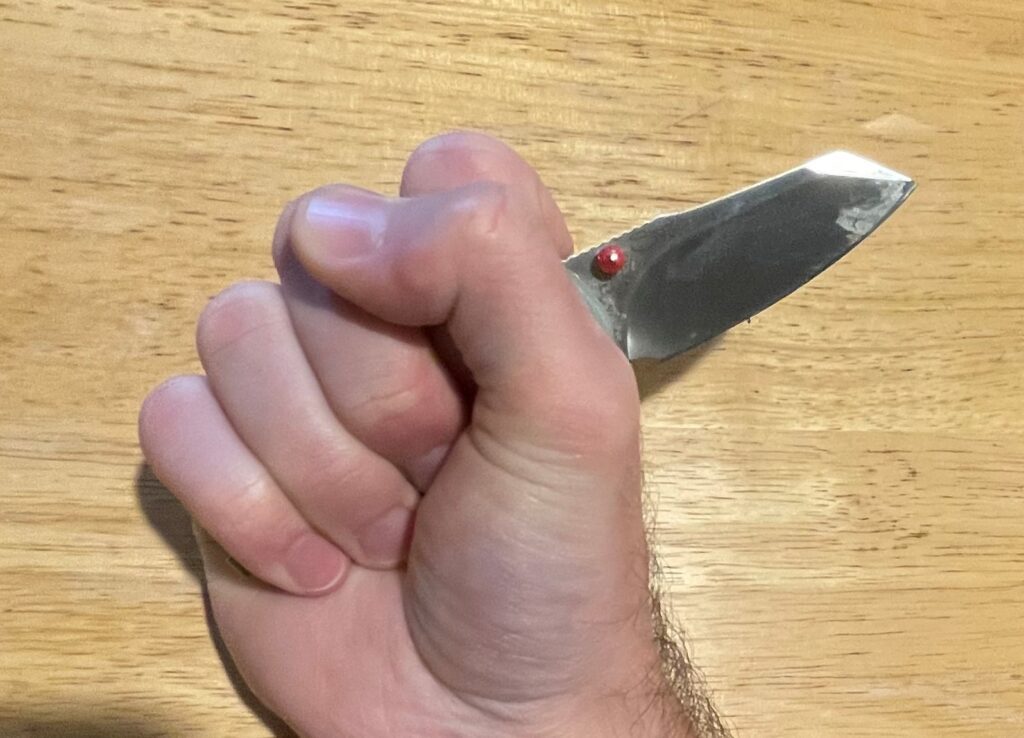
The action of the knife was stiff when I got it, and it actually was pretty tough to use the front flipper at first, but it took me less than a week to break it in, with plenty of fidgeting, of course. Now, the action is silky-smooth, and because of its small size, number of deployment options, and super-slick action, is extremely fidgety. I’m not alone in that judgment of this knife – other critics have said just as much.
Speaking of the action of the Maileah, the ceramic ball bearing is a joy. After you break it in, it feels frictionless. Also, the detent is just perfect. It keeps the blade closed just tightly enough that the proper application of force on the thumb studs or front flipper requires no supplementary wrist action whatsoever to snap the knife open lightning quick.
About deployment: the length and balance of this knife are absolutely perfect. If you handle enough knives, at a certain point you’ll recognize that the longer the blade, the more angular momentum it carries. While this doesn’t make it harder to deploy the blade (in some cases, it makes it easier) it does extend the amount of time it takes to snap the blade open.
I’m talking milliseconds, but it’s noticeable. The CJRB Maileah, with its short, stout blade, can be whipped open in a flash. It opens more quickly than probably any other knife I’ve handled.
Something else I love about the front flipper: its prominence at the top of the knife makes it an ideal pinch point. You know those tasks you come across where you need something sort of like a set of pliers, but for which a set of pliers is not entirely merited? Pressing your thumb against the flipper – as shown below – gives you uncommon leverage that you can’t get between two fingers alone.

The lock is a liner lock. There’s not too much to scream about here. It does what it’s supposed to and there’s no rock one way or the either, with the knife locked open. Moreover, in almost six months of carrying and using the knife everyday, I’ve only had to tighten the pivot screw once, and no play has developed between the lock and blade.
The blade is, in my opinion, basically perfect in size and profile for EDC. It has a stout point that can take a bit of abuse. I don’t need a really fine point for most cutting tasks, and quite frankly I like the “insurance policy” of the stouter tip. It’s just less likely to snap off or chip.
It has a very, very gentle sweep, which some might prefer to a straight, flat edge. It makes arcing cuts very comfortable.
The short length of the blade makes it very easy to control. I never feel like I’m going to slip with this knife, and the blade never feels like it’s too big or long to control.
It’s also small enough that you can really choke down on the point in a sort of “modified” saber grip. By sliding your thumb forward on the spine, you can place it over the top of the “reverse tanto” where the swedge would be. This affords a truly amazing degree of dexterity and control over the edge.

The spine is nearly squared off. It’s not perfectly square, but still sharp enough to scrape tinder or strike sparks from a ferrocerium rod, which is an important attribute for an EDC knife, if you ask me. You could, of course, modify a knife to enable this feature in the event of such a deficiency, but it’s not necessary with the CJRB Maileah.
Something I also really love is the blade steel. Now, to be fair, I’ve only been carrying it for about six months, as I stated, but nothing has caused so much as a speck of rust to rear its ugly head. It gets ten out of ten on corrosion resistance from me, and I am outside in the rain a decent amount. I also don’t habitually clean or dry this knife and it’s been in my pocket every day.
There are a few other things I noticed. The toughness of the steel is no joke. It’s handled light hammering, batoning and piercing with no signs of fatigue. I have not blunted the tip or rolled the edge.
Now, for edge retention. Apparently, this is one of the defining characteristics of AR-RPM9. To be honest, while I’m not underwhelmed, it hasn’t caught my attention for keeping an edge. I could cut through a few boxes or do some light carving, on something light like pine, and even if I went into it with a true razor edge, it’s going to need to be touched up. So it does hold an edge but it’s not going to turn any heads for that.
But – but – the ability to take an edge itself is something I really admire about this knife. Not all steels are created equal, and AR-RPM9 can take a truly sharp edge. It’s as good as, or better than, Buck’s 420HC.
In the hand, this knife also indexes very well and is easy to manipulate instinctually. Not all knives are like that, and the ability to situate a knife in your grip, or to resituate it without having to look at it, is kind of a big deal.
What the CJRB Maileah Could Do Better
While I do love the knife for the reasons I detailed in the previous section, there are some things that CJRB could probably do better. Not that this knife needs to be reimagined. It’s fine the way it is. It’s just that if you’re planning on getting one, you should be aware of these.
I by no means have huge hands. This is a tiny knife and it doesn’t quite satisfactorily fill my grip. As you can see in the image below, the handle doesn’t even span from one side of my hand to the other.
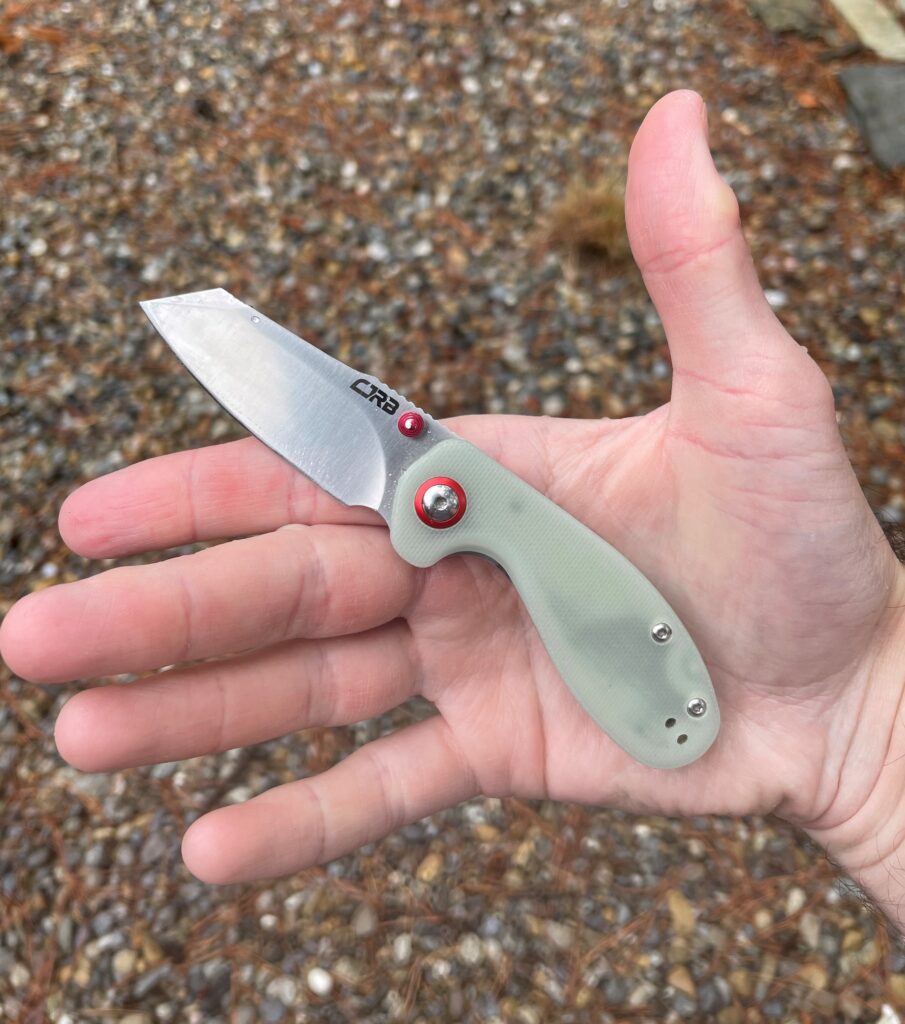
It’s not entirely necessary for a knife to do this, but it makes it a lot more comfortable to use. I can only get a three finger grip on this knife at best. It’s not technically uncomfortable to grip with vigor, but I’d definitely be more confident about it if the handle was just slightly larger.
The truth is, due to the orientation of the choil, I actually enjoy holding this knife in the reverse grip better than in the standard grip. It just fits naturally in my hand better and I would suspect the same for you.
One more thing about the grip. It’s natural for me to want to choke forward on the blade and some knives have a choil or an unsharpened section on the blade forward of the shoulder. This knife doesn’t and my fingers stray just a bit too close to the edge when I choke far up on the grip, as you can see below.
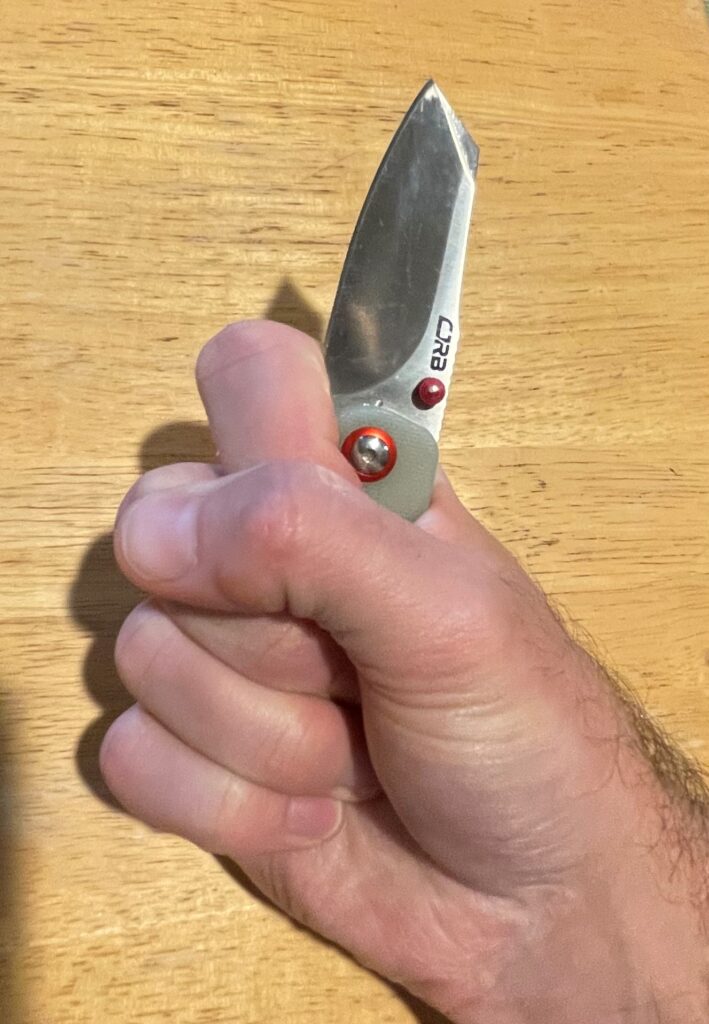
As I mentioned, edge retention isn’t excellent. But that’s hardly a complaint of mine. I actually prefer a softer steel that’s easier to resharpen in the field than a harder steel that’s more likely to chip. But, again, that’s just me.
I also should say that the aesthetics of this knife don’t really appeal to me. But at the same time, cool factor does not justify or redeem a knife that can’t measure up on “tool factor.” A knife should perform first and look the part second. I think the RAT II is a god-awful ugly knife, and in my estimation it is a nearly perfect tool. So take it with a grain of salt. I think the Maileah is not a physically attractive knife, but it is wildly functional.
Overall, there’s one more thing I wish I could say about this knife. I wish it was just a tad bigger. It would fit my grip more comfortably and, due to its larger size, be able to tackle a wider array of heavier tasks with confidence.
If what I’m telling you about this knife appeals to you and you sympathize, then you’ll be glad to know that CJRB and Swaggs went back to the drawing board and amped up the Maileah, releasing the More Maileah before I even published this post.
Good News: There’s a Bigger Maileah in the Picture (The More Maileah)
What is the More Maileah, you ask? Well, it’s literally the Maileah – just larger. Everything about the two models is exactly identical with two exceptions.
The More Maileah is bigger, and instead of red hardware, the More Maileah’s hardware is gold. It’s a touch more handsome.
The More Maileah is also available in different colors, but otherwise, the steel, G10 handles and design are identical to the original. I actually have two Maileahs and two More Maileahs. I only recently invested in the More Maileah so I have much less experience using it.

I can comment on this: it does everything the Maileah does but it’s a little heavier, and blade deployment isn’t as snappy by virtue of the More Maileah’s greater length. Otherwise, the More Maileah is the answer to those of you for whom the original is just a little bit undersized.
The Verdict on the CJRB Maileah, and Where You Can Get One
In summary, these are the things I have to offer in praise of the CJRB Maileah:
It’s discrete.
Comfortable to carry.
Extremely versatile.
It has an excellent blade steel and profile.
It’s highly corrosion resistant.
The action is fluid and there are a number of deployment options.
It’s also fairly affordable.
However, it is not without drawbacks:
Edge retention is not the best.
The knife is a little small.
Handles better in the reverse grip than the standard grip.
As you can see from my estimation, the benefits of this knife, though basic, significantly outweigh the few shortcomings I can muster.
I got two Maileahs from Smoky Mountain Knife Works (SMKW.com) for under $30 each. I also got my More Maileahs from Knife Center (KnifeCenter.com). As far as I know, their price on the More Maileah is the best.
I will be honest. Prior to my purchase of the CJRB, I was skeptical of the brand in general. It’s relatively new and just seemed like a cheap attempt to imitate the sound of “CRKT,” which is another well-established knife company and seen by many as a premier producer of practical folding knives.
Plus, I already had and loved the CRKT Pilar, which may be a topic for another blog. That was a high bar to meet, especially since the Maileah is so like the Pilar in so many ways.
But CJRB met the bar and passed it. I do not regret buying this knife and for the price you’ll have a hard time doing better in a pocket cleaver of this style and capability. I hate to admit it – the CRKT Pilar is a much tougher, stouter knife, but the CJRB has it beat pretty comfortably on steel quality.
This much I will also say. My skepticism of CJRB was unwarranted despite the fact that CJRB sounds like a hokey ripoff of an established brand. Perhaps they erred in choosing that name, but the Maileah is a quality blade. I rotate through a bunch of other knives, but this little one isn’t going anywhere – and while it can’t supplant a fixed blade, it’s definitely one of my favorite folders.
Have any of you carried a Maileah or another CJRB knife? Let me know what your experiences have been in the comments, or let me know anything you’d like me to cover in my next post.

Update on My CJRB Maileah Review
It’s now been just about a year and a half that I’ve been carrying the CJRB Maileah pretty much every day, and I wanted to come back to this review and update it with two observations.
One is that the AR-RPM9 is as good as I assumed it would be in terms of corrosion resistance. I’ve carried it in the rain and it’s stayed wet for prolonged periods of time and never so much as a spot of rust has shown up in all that time.
With that said, the steel is softer than I thought it was at first. I can make it ripping sharp (check out my post on how to get your knife really sharp) but it won’t stay that sharp for too long.
It’s not chipping or rolling though. I think it’s just getting rounded or actually wearing away. I assume it’s the former. Either way, a few passes on the stone and it’s good.
The other thing I wanted to mention has to do with the front flipper tab. I previously commented on it because it improves the fidget factor of the knife and it adds a deployment method.
But, as you can see from the image above, I find myself increasingly using the front flipper as an improving pry bar. This keeps me from having to add a dedicated pry tool to my EDC rotation and is a welcome feature.
I’ve used this flipper tab for opening cans of paint (or lacquer, as pictured), to open bottles, and for leverage when pulling on cord or fabric. It’s pretty versatile, and highly useful. It also adds to my appreciation for this knife, which has been my EDC go-to for almost a year and a half now.
So, to reiterate, I really think this is a practical and well-designed knife.
Stay sharp.
~The Eclectic Outfitte